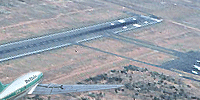 |
|
By
Wikipedia,
the free encyclopedia,
https://en.wikipedia.org/wiki/Luna_10 Luna 10 (E-6S series) was an unmanned space mission of the Luna program, also called Lunik 10. The Luna 10 spacecraft was launched towards the Moon from an Earth orbiting platform on March 31, 1966. It was the first artificial satellite of the Moon (or another heavenly body, for that matter). The spacecraft entered lunar orbit on April 3, 1966 and completed its first orbit 3 hours later (on April 4, Moscow time). Scientific instruments included a gamma-ray spectrometer for energies between 0.3—3 MeV (50–500 pJ), a triaxial magnetometer, a meteorite detector, instruments for solar-plasma studies, and devices for measuring infrared emissions from the Moon and radiation conditions of the lunar environment. Gravitational studies were also conducted. The spacecraft played back to Earth The Internationale during the Twenty-third Congress of the Communist Party of the Soviet Union. Luna 10 was battery powered and operated for 460 lunar orbits and 219 active data transmissions before radio signals were discontinued on May 30, 1966.
Luna 10
|
| Mission type |
Lunar orbiter |
| COSPAR ID |
1966-027A |
| SATCAT no. |
2126 |
| Mission duration |
60 days |
| Spacecraft properties |
| Spacecraft type |
E-6S |
| Manufacturer |
GSMZ Lavochkin |
| Launch mass |
1,582 kilograms (3,488 lb) |
| Start of mission |
| Launch date |
March 31, 1966, 10:48:00 UTC |
| Rocket |
Molniya-M 8K78M |
| Launch site |
Baikonur 31/6 |
| End of mission |
| Last contact |
May 30, 1966 |
| Orbital parameters |
| Reference system |
Selenocentric |
| Semi-major axis |
2,413.0 kilometres (1,499.4 mi) |
| Eccentricity |
0.14 |
| Periselene |
2,088 kilometres (1,297 mi) |
| Aposelene |
2,738 kilometres (1,701 mi) |
| Inclination |
71.9 degrees |
| Period |
178.05 minutes |
| Lunar orbiter |
| Orbital insertion |
April 3, 1966, 18:44 UTC |
| Instruments |
Magnetometer
Gamma-ray spectrometer
Five gas-discharge counters
Two ion traps/charged particle trap
Piezoelectric micrometeorite detector
Infrared detector
Low-energy x-ray photon counters |
After a midcourse correction on 1 April, Luna 10, the second of two hastily prepared Soviet Ye-6S probes (that is, the backup), successfully entered lunar orbit two days later at 18:44 UT, thus becoming the first man-made object to go into orbit around another planetary body. A 245-kilogram instrument compartment separated from the main bus, which was in a 350 x 1,000-kilometer orbit inclined at 71.9° to the lunar equator. The spacecraft carried a set of solid-state oscillators that had been programmed to reproduce the notes of the Internationale so that it could be broadcast live to the 23rd Communist Party Congress. During a rehearsal on the night of 3 April, the playback went well, but the following morning, controllers discovered a missing note and played the previous night’s tape to the assembled gathering at the Congress—claiming it was a live broadcast from the Moon. Luna 10 conducted extensive research in lunar orbit, gathering important data on the weakness of the Moon’s magnetic field, its radiation belts, and the nature of lunar rocks (which were found to be comparable to terrestrial basalt rocks), cosmic radiation, and micrometeoroid density. Perhaps its most important finding was the first evidence of mass concentrations (called “mascons”)—areas of high density below the mare basins that distort lunar orbital trajectories. Their discovery has usually been credited to the American Lunar Orbiter series. Last contact was on 30 May 1966.
- Launch Date/Time: 1966-03-31 at 10:48:00 UTC
- On-orbit dry mass: 540 kg
External links
Text from Wikipedia is available under the Creative Commons Attribution/Share-Alike License; additional terms may apply.
Published in July 2009.
Click here to read more articles related to aviation and space!
|
 |



